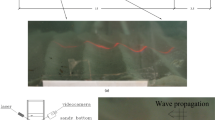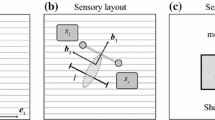Abstract
The bioluminescence emitted by micro-planktonic organisms has been adopted to detect shear stresses within oscillating flows over small scale bedforms. To this aim, an experimental campaign has been planned in order to optimize optical detectors and to address peculiar needs of biological organisms.
Oscillating flow over ripples has been simulated in an annular cell, an apparatus that permits one to carry out experiments on ripple formation under well controlled conditions. Bioluminescence emission within the annular cell ascertains the existence of a high shear stress regime induced by the presence of the rippled bed in the range of Reynolds numbers between 2000 and 11000. Stress maps obtained from the experimental campaign showed the stronger stresses close to the rippled bed, with maximum values ranging between 15 and 35 Pa. 2D numerical simulations of oscillating flows over a rippled bed have been also run reproducing the experimental conditions, showing a good agreement on the position of the high stress regions, but underpredicting the maximum shear stress.
Bioluminescence appears to be a valid instrument to characterize the flow and in particular to visualize high stress areas, leading to the possibility to measure shear stresses directly. Though limits occur, mostly due to the difficulties of dealing with biological organisms, such an approach can be considered as a starting point for the development of a bio-inspired visually based system for flow measurements.
Similar content being viewed by others
References
Anderson DM, Nosenchuck DM, Reynolds GT, Walton A (1988) Mechanical stimulation of bioluminescence in the dinoflagellate gonyaulax polyedra stein. J Exp Mar Biol Ecol 122(3):277–288
Arnskov MM, Fredsøe J, Sumer BM (1993) Bed shear stress measurements over a smooth bed in three dimensional wave-current motion. Coast Eng 47:431–441
Belluso M, Bonanno G, Calí A, Carbone A, Cosentino R, Modica A, Scuderi S, Timpanaro C, Uslenghi M (2001) A new photon counting detector: intensified CMOS-APS. Number 4498 in SPIE
Bityukov EP (1971) Bioluminescence in the wake current in the Atlantic ocean and Mediterranean sea. Okean 11:127–133
Blaser S, Kurisu F, Satoh H, Mino T (2002) Hydromechanical stimulation of bioluminescent plankton. Luminescence 17:370–380
Bonanno G, Belluso M, Calí A, Timpanaro C, Uslenghi M, Fiorini M, Modica A (2001) Photon counting system based on intensified CMOS-APS: PC-IAPS. Number 4498 in SPIE
Cussatlegras A, Le Gal P (2004) Bioluminescence of the dinoflagellate pyrocystis noctiluca induced by laminar and turbulent couette flow. J Exp Mar Biol Ecol 310:227–246
Cussatlegras A, Le Gal P (2005) Diniflagellate bioluminescence in response to mechanical stimuli in water flows. Nonlinear Processes Geophys 12:337–343
Cussatlegras A, Le Gal P (2007) Variability in the bioluminescence response of the dinoflagellate pyrocystis lunula. J Exp Mar Biol Ecol 343:74–81
Deane GB, Stokes MD (2005) A quantitative model for flow induced bioluminescence in dinoflagellates. J Theor Biol 237:147–169
Faraci C, Foti E, Musumeci RE (2008) Waves plus currents at a right angle: the rippled bed case. J Geophys Res 113:C07018. doi:10.1029/2007JC004468
Foti E, Scandura P (2004) A low Reynolds number k−ε model validated for oscillatory flows over smooth and rough wall. Coast Eng 51:173–184
Foti E, Faraci C (2005) Prediction of bedform and bed roughness in combined steady and oscillatory flows. In: van Rijn L et al. (ed) SandPit project book. Aqua Publ., The Netherlands
Fredsøe J, Andersen KH, Sumer BM (1999) Wave plus current over a ripple-covered bed. Coast Eng 38:177–221
Gooch V, Vidaver W (1980) Kinetic analysis of the influence of hydrostatic pressure on bioluminescence of goniaulax polyedra. Photochem Photobiol 31(4):397–402
Harvey EN (1952) Bioluminescence. Academic Press, New York
Herring PJ (1998) Dolphins glow with the flow. Nature 393:731–732
Kelly CJ, Tumsaroj N, Lajoie C (2004) Assessing wastewater metal toxicity with bacterial bioluminescence in a bench-scale wastewater treatment system. Water Res 38:423–431
Latz MI, Frangos JA (1995) Bioluminescence of marine plankton cells in response to defined fluid shear stress. Biorheology 32:158–163
Latz MI, Juhl AR, Ahmed AM, Elghobashi SE, Rohr J (2004) Hydrodynamic stimulation of dinoflagellate bioluminescence: a computational and experimental study. J Exp Biol 207:1941–1951
Latz MI, Rohr J (1999) Luminescent response of the red tide dinoflagellates lingulodinium polyedrum to laminar and turbulent flow. Limnol Oceanogr 44:1423–1435
Latz MI, Case JF, Gran RL (1994) Excitation of bioluminescence by laminar fluid shear associated with simple couette flow. Limnol Oceanogr 39:1424–1439
Latz MI, Rohr J, Hoyt J (1995) A novel flow visualization technique using bioluminescent marine plankton. Flow Vis 7:28–33
Latz MI, Bovard M, VanDelinder V, Segre E, Rohr J, Groisman A (2008) Bioluminescent response of individual dinoflagellate cells to hydrodynamic stress measured with millisecond resolution in a microfluidic device. J Exp Biol 211:2865–2875
Latz MI (2009) Pers comm to GB Deane
Loo WTY, Tong JMK, Cheung MNB, Chow LWC (2006) A new predictive and prognostic marker (ATP bioluminescence and positron emission tomography) in vivo and in vitro for delivering adjuvant treatment plan to invasive breast tumor patients. Biomed Pharmacother 60:285–288
Madsen OS (1993) Sediment transport on the shelf. Technical report, Parsons Lab MIT, Massachusetts
Nielsen P (1992) Coastal bottom boundary layers and sediment transport. World Scientific, Singapore
Ourmieres Y, Chaplin JR (2004) Alexandrium tamarense species summary. In: Hewitt CL, Martin RB, Sliwa C, McEnnulty, FR, Murphy, NE, Jones T, Cooper, S, (eds) National introduced marine pest information system
Ourmieres Y, Chaplin JR (2004) Visualization of the disturbed-laminar wave-induced flow above a rippled bed. Exp Fluids 36(6):908–918
Paerl HW (1988) Nuisance phytoplankton blooms in coastal, estuarine, and inland waters. Limnol Oceanogr 33(4):823–847, Part I
Rohr J, Losee J, Anderson G (1994) The response of bioluminescent organisms to fully developed pipe flow. Technical Report 1360, Naval Command Control and Ocean Surveillance Center, RDT&E Div
Rohr J, Allen J, Losee J, Latz MI (1997) The use of bioluminescence as a flow diagnostic. Phys Lett A 228:408–416
Rohr J, Latz MI, Fallon S, Nauen JC, Hendricks E (1998) Experimental approaches towards interpreting dolphin-stimulated bioluminescence. J Exp Biol 201:1447–1460
Rohr J, Hyman M, Fallon S, Latz MI (2002) Bioluminescence flow visualization in the ocean: an initial strategy based on laboratory experiments. Deep-Sea Res 49:2009–2033, Part I
Scherer MA, Melo F, Marder M (1999) Sand ripples in an oscillating annular sand-water cell. Phys Fluids 11(1):58–67
Sleath JFA (1976) On rolling grain ripples. J Hydraul Res 14:69–81
Staples RF (1966) The distribution and characteristics of surface bioluminescence in the oceans. Technical Report 184, Naval Oceanographic Office
Stegner A, Wesfreid JE (1999) Dynamical evolution of sand ripples under water. Phys Rev E 60(4):R3487–R3490
Stokes MD, Deane GB, Latz MI, Rohr J (2004) Bioluminescence imaging of wave-induced turbulence. J Geophys Res 109:C01004
Sumer BM, Arnskov MM, Christiansen N, Jorgensen FE (1993) Two-component hot-film probe for measurement of wall shear stress. Exp Fluids 15:380–384
Sweeney BM (1984) Circadian rhythmicity in dinoflagellates. Academic Press, Orlando, pp 343–364
Tarasov NI (1956) Marine luminescence. Technical Report NOO T-21, Naval Oceanographic Office
Uslenghi M, Bonanno G, Belluso M, Calí A, Timpanaro C, Cosentino R, Scuderi S, Modica A (2002) Progress on photon counting intensified. APS, Number 4498 in SPIE
van Driest ER (1956) On turbulent flow near a wall. J Aeronaut Sci 23(11):1007–1011
Author information
Authors and Affiliations
Corresponding author
Rights and permissions
About this article
Cite this article
Foti, E., Faraci, C., Foti, R. et al. On the use of bioluminescence for estimating shear stresses over a rippled seabed. Meccanica 45, 881–895 (2010). https://doi.org/10.1007/s11012-010-9301-4
Received:
Accepted:
Published:
Issue Date:
DOI: https://doi.org/10.1007/s11012-010-9301-4




